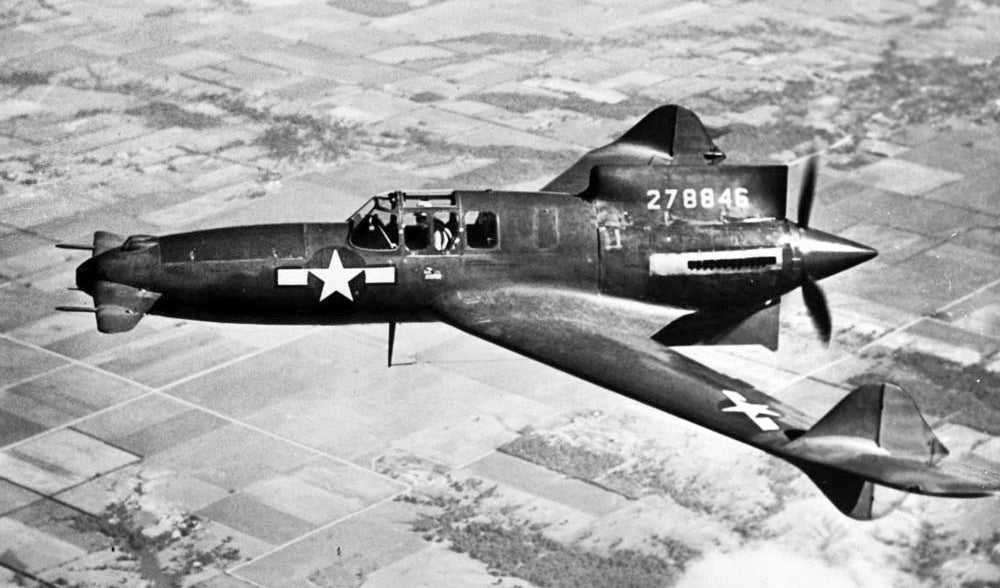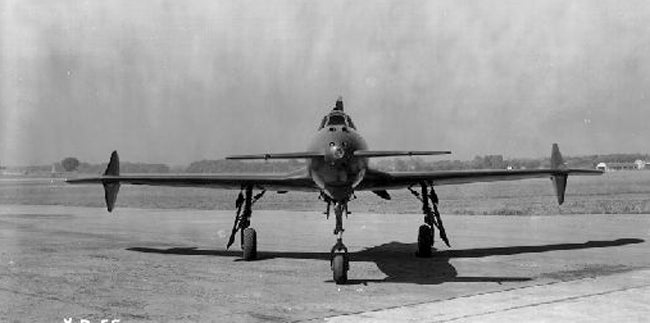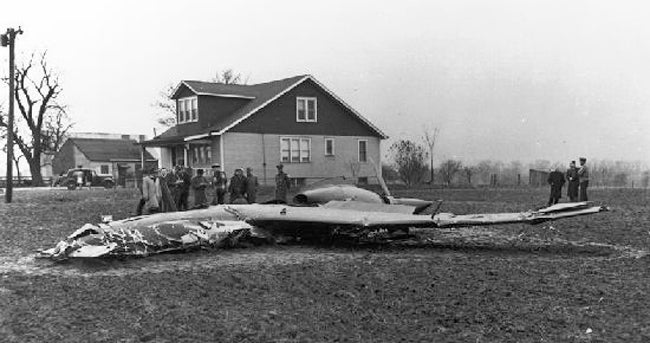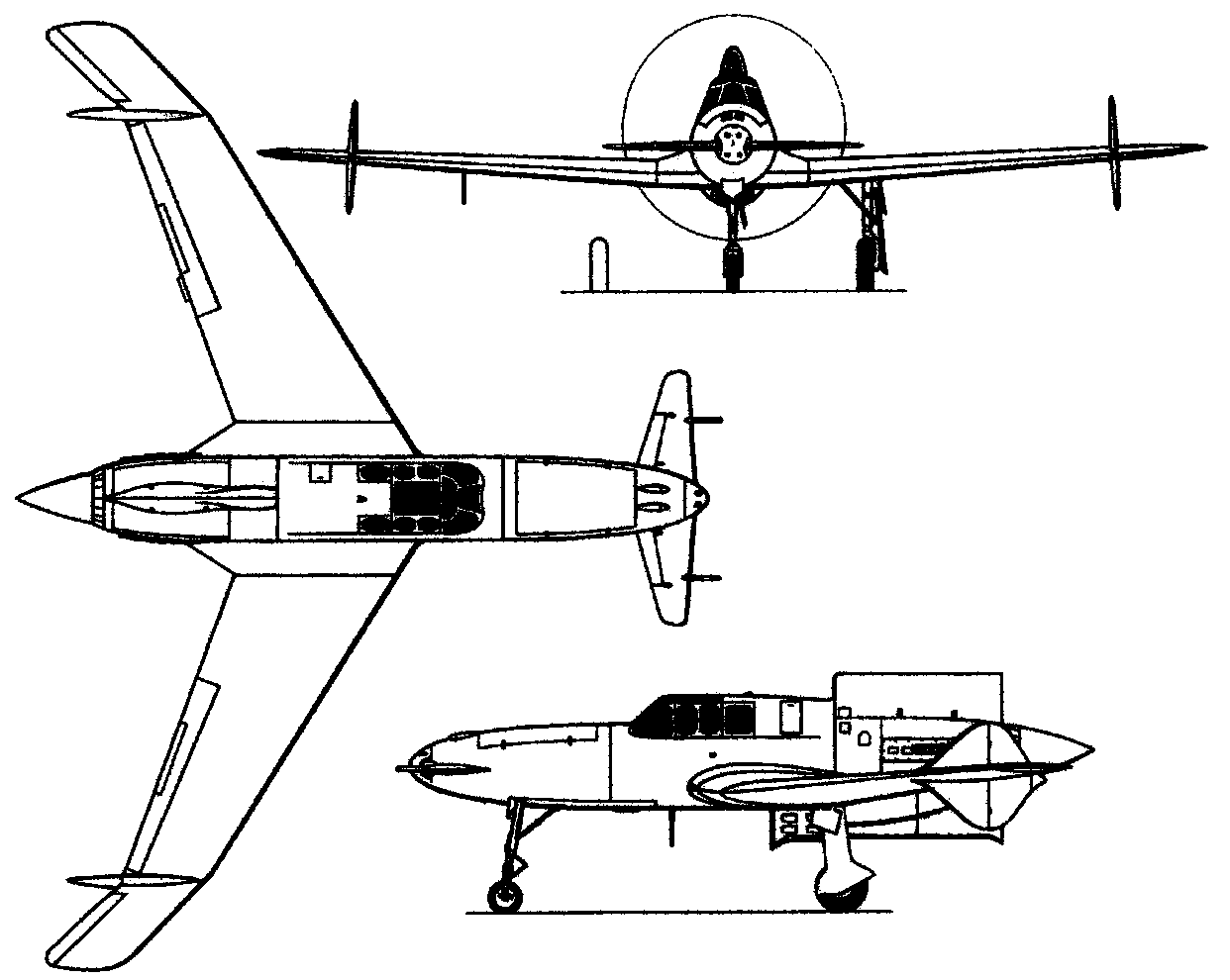 by "ttyymmnn" (ttyymmnn)
by "ttyymmnn" (ttyymmnn)
Published 10/25/2017 at 13:15
 by "ttyymmnn" (ttyymmnn)
by "ttyymmnn" (ttyymmnn)
Published 10/25/2017 at 13:15
Tags: wingspan
; Planelopnik
; planes you've (probably) never heard of
STARS: 9
Fearing that American aircraft development was stagnating in the face of technological advances made overseas, the US Army Air Corps issued
Request for Data R-40C
in 1940 which the Army hoped would encourage designers to create innovative new aircraft that went beyond the traditional monoplane with engine in front arrangement that had become standard during the 1930s. Three aircraft came out of this request: the Vultee XP-54, the Curtiss XP-55 Ascender, and the radical Northrop XP-56 Black Bullet.
!!! UNKNOWN CONTENT TYPE !!!
This is the second installment in a three-part series that takes a look at the Request for Data R-40C aircraft.
!!! UNKNOWN CONTENT TYPE !!!

The Army’s request for innovative aircraft designs produced three of the more radical warplanes that ever took to the skies, but in one way, the Curtiss-Wright Ascender was a throwback to the earliest days of flight. Though swept wings had been the subject of experimentation since the dawn of aviation, it was rare to see them on propeller aircraft of the 1940s. With its rear-mounted swept wing and long fuselage, the Ascender was essentially a flying wing with a forward canard for trimming stability, and essentially the same arrangement used on the Wright Flyer of 1903.

Like the Vultee XP-54, the Ascender had its engine mounted in the rear (earning it the sarcastic nickname “Ass-ender”) and, like the XP-54, Curtiss had hoped to use the Pratt & Whitney X-1800 engine. But, with the cancelation of the H-block hyper engine, Curtiss substituted a less powerful Allison V-1710 V-12. But the placement of a spinning propeller directly behind the cockpit caused concerns for pilot safety in the event of an emergency exit. While Vultee used a downward sliding seat in the Swoose Goose, Curtiss developed a system that jettisoned the propeller before the pilot bailed out.

Curtiss built a powered scale model for wind tunnel testing, but when those tests proved inadequate they built the first of three full-sized prototypes. The Ascender took its first flight on July 13, 1943, but the takeoff run was so long that the nose elevator was enlarged and the wing was modified to increase lift. Once in the air, the the XP-55 flew well enough, but it showed particularly nasty stall characteristics. During a test flight in November 1943, the plane pitched over onto its back and the pilot was unable to recover. Dropping inverted from 16,000 feet, the pilot eventually bailed out, but the prototype was destroyed. The second and third Ascenders were modified by the addition of extended “trailerons” to help with stall characteristics, but stall testing was forbidden.

Flight testing ultimately demonstrated that the Ascender showed no great gains in performance over traditional fighter aircraft of the time. With testing already underway on a new generation of jet fighters, the Ascender was abandoned, but not before the loss of the third prototype in a 1945 crash that killed the pilot and four civilians on the ground. The sole remaining Ascender is now part of the collection of the Smithsonian Air and Space Museum, and is currently on long-term loan to the Air Zoo museum in Kalamazoo, Michigan.

!!! UNKNOWN CONTENT TYPE !!!
!!! UNKNOWN CONTENT TYPE !!!
!!! UNKNOWN CONTENT TYPE !!!
!!! UNKNOWN CONTENT TYPE !!!
!!! UNKNOWN CONTENT TYPE !!!
!!! UNKNOWN CONTENT TYPE !!!
!!! UNKNOWN CONTENT TYPE !!!
If you enjoyed this post, please join in the conversation and let me know. For more posts about aviation history and aircraft oddities, head over to
Wingspan
.
!!! UNKNOWN CONTENT TYPE !!!
 "For Sweden" (rallybeetle)
"For Sweden" (rallybeetle)
10/25/2017 at 13:19, STARS: 7
Is Airplane Tales a series about airplanes without tails? I would support that.

10/25/2017 at 13:50, STARS: 4
It’s interesting how the -54, -55, -56, and the -67 for that matter, are cutting edge and yet outdated at the same time; it’s a testament to how fast aeronautics advanced during the war.
 "Ash78, voting early and often" (ash78)
"Ash78, voting early and often" (ash78)
10/25/2017 at 14:23, STARS: 2
Like the Vultee XP-54, the Ascender had its engine mounted in the rear (earning it the sarcastic nickname “Ass-ender”)
My old man always told me that the worst kept secret in aviation was that they actually named it “Ascender” for that exact reason — ie, it wasn’t a nickname assigned later.
If you know any aero engineers, you wouldn’t doubt this story. OTOH, the most poignant part of growing up (for me) was realizing how mcuch bullsh*t my dad spouted for years. Now I have kids and it’s my turn!